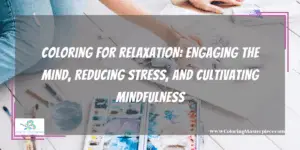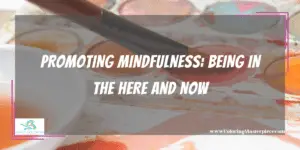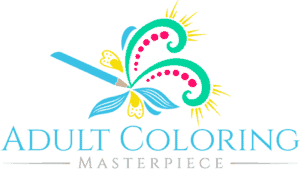Finding moments of calm and relaxation in our hectic and fast-paced environment has become a need for maintaining overall well-being. While many activities claim to provide solace, one surprising yet joyful activity has won the hearts of both adults and children: coloring.
In this article, we will look at the art of coloring for relaxation and the numerous benefits it has for people of all ages. Join us on this colorful trip as we discover the beauty of coloring and its tremendous potential to bring serenity to our lives, whether you are an adult seeking a respite from the challenges of maturity or a youngster discovering delight in every stroke.
Coloring for Relaxation: Engaging the Mind, Reducing Stress, and Cultivating Mindfulness

The pursuit of leisure has taken on new relevance in the middle of our fast-paced and demanding environment. Individuals are increasingly finding ways to unwind and find moments of respite as the strains of modern life continue to grow. In response to this expanding need, a wide range of activities and practices have evolved, all promising to relieve stress and usher in a sense of calm. Surprisingly, coloring has emerged as a significant ally in the pursuit of serenity.
Coloring, which was once limited to the sphere of children’s entertainment, has experienced a spectacular transition in recent years, acquiring enormous appeal among adults as a genuine source of leisure. This seemingly simple pastime, which is frequently dismissed as child’s play, has proven to be a useful and pleasurable way for adults to relax, reconnect with their inner selves, and experience a sense of serenity.
Coloring for relaxation is more than just filling in the lines of a picture; it is a deliberate and contemplative process that engages the mind in a state of flow. Flow, as defined by renowned psychologist Mihály Cskszentmihályi, is a mental state in which humans become completely engrossed in an activity, losing track of time and avoiding the pressures of the outside world. When one enters the creative world of coloring, the mind is completely focused on the activity at hand, providing a much-needed mental vacation from the stresses of daily life.
The rhythmic process of choosing colors, deciding where to apply them, and seeing the artwork take shape grabs the individual’s attention and concentration, generating a profound sensation of contentment and relaxation. This deep and creative getaway allows for the recovery of one’s childish wonder and joy, allowing for a momentary relief from adulthood’s obligations.
Coloring has been scientifically demonstrated to be a great stress reliever in addition to providing a creative outlet. Coloring triggers the brain’s reward region, causing dopamine, the neurotransmitter responsible for emotions of pleasure and happiness, to be released. This dopamine surge not only relieves stress but also promotes a pleasant mood, allowing individuals to face problems with better resilience and lucidity.
Coloring can promote mindfulness—the discipline of being present and aware of the present moment. When people concentrate on the physical sensations of coloring—the texture of the paper, the movement of their hand, and the blending of colors—they anchor themselves in the now, distancing themselves from worries about the past or the future. Coloring has a meditative quality due to its repetitive and rhythmic character, which encourages a deeper connection with one’s thoughts and emotions.
Coloring regularly might provide several benefits to one’s general well-being. Participating in creative hobbies, such as coloring, has been shown in studies to alleviate feelings of anxiety and sadness. Completing a coloring page provides a sense of competence while sharing creative experiences with people in group situations develops social ties, which are necessary for mental wellness.
Engaging the Mind: A Creative Escape
Coloring is a multidimensional activity that goes beyond simply filling in lines. It is a creative and immersive process that requires focus and attention, opening the door to a state of flow, as introduced by psychologist Mihály Cskszentmihályi. When we color, our thoughts become entirely engrossed in the activity at hand, resulting in a meditative-like state that allows us to escape the stresses and worries of our daily lives.
A universe of limitless possibilities opens up inside the constraints of coloring pages. Choosing colors, deciding where to apply them, and watching a blank canvas develop into a colorful masterpiece all take significant brain effort. As we make these decisions and enjoy the creative process, our thoughts become fascinated, briefly free of the worries and distractions that frequently afflict us.
Coloring patterns or shapes regularly adds to its attraction as a relaxation strategy. This repetitive action has a calming impact on the mind, similar to the rhythmic beats of relaxing music. With each color stroke, mental chatter begins to fade, creating room for a calm and concentrated state of mind. We find sanctuary from the incessant stream of thoughts and anxieties in this condition, allowing us to feel a sense of serenity and clarity.
We are asked to use our imaginations and reconnect with our inner children by coloring. We rediscover the delight of discovery and the wonder of unrestricted creation when we move beyond the limits of traditional color schemes. This process of self-expression not only feeds the spirit but also promotes a sense of joy and relaxation, reminiscent of carefree childhood memories.
Coloring for relaxation offers far-reaching effects in addition to its initial appeal. The activity’s meditative character allows us to tap into our intrinsic ability to center ourselves and achieve equilibrium amid life’s chaos. It creates much-needed mental space, providing a respite from the continual demands and responsibilities of modern life.
We can create a deeper connection with ourselves and a greater awareness of the present moment by coloring regularly. Coloring allows us to slow down and appreciate life’s little joys. With each color stroke, we are reminded that relaxing is not a luxury but a necessity for general well-being.
Reducing Stress: A Therapeutic Outlet
Stress has become an all too familiar companion in our modern culture, affecting the lives of many people and taking a toll on both their physical and mental health. Work, family, and other duties can create an overwhelming sense of strain, leaving us yearning for times of relaxation and relief. Fortunately, the seemingly simple act of coloring can give a strong therapeutic outlet to relieve stress and relax.
Numerous studies have shown that coloring has a soothing effect on the brain, notably on the amygdala, the region responsible for emotion processing. When we engage in the rhythmic action of coloring, our brain’s reward center activates, causing the release of dopamine, also known as the “feel-good” neurotransmitter. This dopamine surge adds to feelings of well-being and contentment, reducing the effects of stress and creating a happy mood.
Coloring, in addition to its neurological benefits, is an effective approach to reaching mindfulness—a condition of being present and aware of the present moment. We frequently find ourselves trapped in the trap of rumination in our fast-paced lifestyles, where anxieties about the past or future absorb our thoughts and prolong uneasiness. Coloring, on the other hand, offers a welcome distraction that brings us into the present now, providing a momentary break from this loop of negative thinking.
Our attention becomes firmly fixed on the creative process as we focus on selecting colors, deciding where to apply them, and seeing the gradual transformation of a blank canvas into a colorful artwork. The rich intricacies of the coloring page capture our attention, diverting our attention away from the stresses of daily life. We have a restored sense of clarity and mental calm in this moment of concentrated participation.
Coloring becomes more than just a leisure activity; it becomes a great tool for self-care and stress alleviation. It allows us to escape the overwhelming constraints of the outer world and allows us to recalibrate and regain our sense of equilibrium.
Promoting Mindfulness: Being in the Here and Now

In the pursuit of better mental health, mindfulness has emerged as a potent practice, hailed for its potential to foster a profound sense of awareness and inner serenity. Coloring is an unusually excellent tool for fostering awareness among the different methods available.
When we go on a coloring adventure, the act of coloring extends beyond the application of colors on paper. Instead, it serves as a bridge to mindfulness, allowing us to be fully present in the moment and conscious of our surroundings. We develop accustomed to the physical sensations of the activity, such as the silky texture of the paper beneath our fingers, the subtle movement of our hand as we glide the coloring tool, and the enthralling sense of colors merging beautifully together.
By focusing our attention on these sensory impressions, we securely anchor ourselves in the present, providing a little break from the constant pressures and distractions of the outside world. Yesterday’s troubles and tomorrow’s uncertainties are temporarily quiet, providing us with a priceless moment of stillness.
Coloring’s repetitive and rhythmic character enhances the meditative quality of the exercise, bringing us into a state of intense focus. The rhythmic motion of coloring provides a relaxing and reassuring cadence, similar to the repetitive beats of a calming tune. This rhythm becomes a doorway to introspection, cultivating a deep connection with our inner thoughts and feelings.
We become more aware of our sensations and ideas while we color, studying them with gentle curiosity and without judgment. This self-compassionate approach to our inner world allows us to accept and understand our feelings rather than denying or responding to them. With each color stroke, we identify our ideas and feelings as they arrive, and then gently let them go, similar to how clouds drift across a peaceful sky.
Coloring acts as an emotional sanctuary in this mindfulness embrace—a zone where we can explore and nourish our inner selves. We create emotional resilience through this exercise, fostering the ability to face life’s adversities with calm and grace.
Improved Well-Being: A Path to Tranquility
Coloring for relaxation is more than just a leisure activity; it can have a substantial impact on overall well-being. Regular engagement in creative hobbies, such as coloring, has been demonstrated in scientific research to significantly reduce symptoms of anxiety and sadness. Coloring taps into our inner creativity and helps us to freely express ourselves on paper, acting as a therapeutic release for emotions and stress.
Completing a coloring page may be a tremendously fulfilling experience, and this sense of accomplishment extends beyond creative ability. It improves self-esteem and instills a sense of competence, reminding us of our potential to create and achieve beautiful things. This newfound confidence frequently transcends the coloring session, resulting in increased self-assurance in other areas of life.
Coloring is a diverse hobby that can be enjoyed alone or with others. Coloring becomes a potent stimulus for creating social relationships when shared in a group setting—a critical part of preserving emotional wellness and a sense of belonging. Coloring with friends, family, or strangers can lead to meaningful conversations, bonding over shared experiences, and the exchange of ideas. As the colors come to life on paper, so does the friendship among the participants, creating a welcoming and inclusive environment.
There are no restrictions or limitations in the world of coloring. Everyone, regardless of age or artistic talent, may enjoy the delight of coloring, making it a pastime that draws people together from all walks of life. Individuals can relax and be themselves in the lack of judgment or competition, embracing their creativity without fear of censure. Friendships are formed and a feeling of community grows in this accepting environment.
We open ourselves up to new viewpoints and ideas when we share our creative experiences with others. Colors, patterns, and techniques exchange become a metaphor for the richness of human variation, allowing us to learn from one another and evolve as individuals. The whole relaxing experience is enhanced by these exchanges, as the coloring journey morphs into a shared adventure.
The information provided by ColoringMasterpiece.com (“The Site”) is for general informational purposes only. All information on the Site is provided in good faith, however, we make no representation or warranty of any kind, express or implied, regarding the accuracy, adequacy, validity, reliability, availability, or completeness of any information on the Site. Under no circumstance shall we have any liability to you for any loss or damage of any kind incurred as a result of the use of the Site or Reliance on any information provided on the Site. Your use of the Site and your reliance on any information on the Site is solely at your own risk. This blog post is for educational purposes only and does not constitute legal advice. Please consult a legal expert to address your specific needs.
Terms and Conditions: https://coloringmasterpiece.com/terms-and-conditions/

